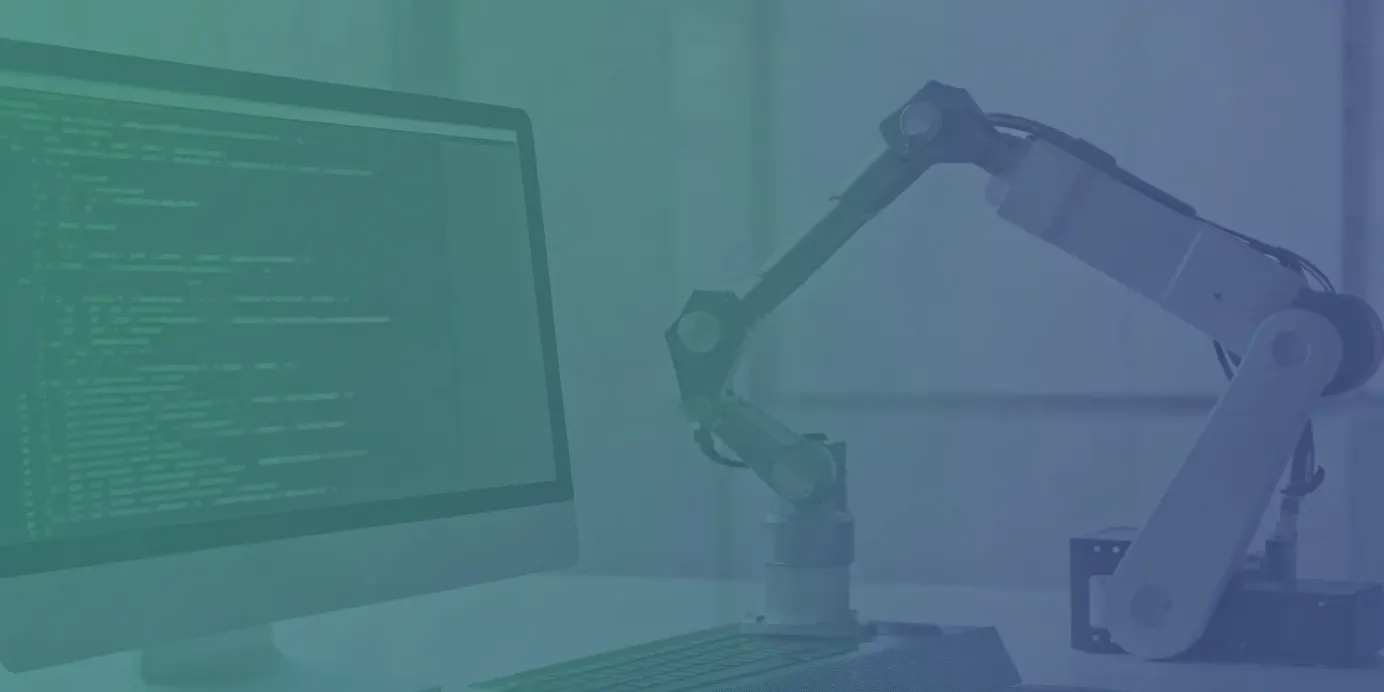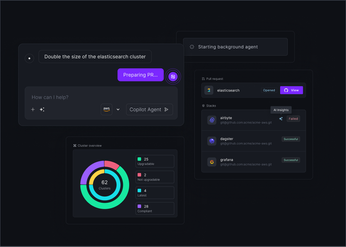
Pull vs. Push Kubernetes Deployment: Which to Choose?
Compare pull-based vs push-based Kubernetes deployment models, including security, scalability, and best practices for managing clusters at any scale.
The key distinction between pull-based and push-based Kubernetes deployments lies in control flow. In a push-based model, an external CI/CD system connects to the cluster’s API server and pushes configuration updates. This setup requires exposing the cluster to inbound traffic and managing sensitive credentials outside the cluster, increasing security risks.
A pull-based model inverts this relationship. An in-cluster agent initiates outbound (egress-only) connections to retrieve configuration and apply changes locally. Because the control plane remains private, there’s no need to expose the API server or distribute credentials externally. This agent-based pull architecture (used by platforms like Plural) enhances security by eliminating external administrative access and minimizing the network attack surface.
Unified Cloud Orchestration for Kubernetes
Manage Kubernetes at scale through a single, enterprise-ready platform.
Key takeaways:
- Adopt a pull model for a more secure architecture: By operating from within the cluster, this model eliminates the need for external systems to hold administrative credentials, drastically reducing your attack surface.
- Use a pull model to effectively manage growing fleets: It decentralizes deployment logic to an agent in each cluster, avoiding the bottlenecks of a central CI tool and ensuring performance scales as your infrastructure grows.
- Separate CI from CD by choosing a pull-based workflow: This creates a clear division of responsibility where your CI pipeline builds artifacts and updates Git, while an in-cluster agent independently manages deployment and state reconciliation.
Pull vs. Push: What’s the Difference in Kubernetes Deployments?
In Kubernetes, the method you use to deploy workloads has a direct impact on security, scalability, and operational consistency. The two dominant approaches (push-based and pull-based deployments) differ primarily in where deployment logic resides and what initiates updates. A push model sends changes into the cluster from an external system, while a pull model uses an in-cluster agent to fetch and apply updates from a trusted source. Understanding this difference is key to designing a secure and resilient continuous deployment strategy.
What Is a Pull-Based Deployment?
In a pull-based setup, an agent inside the cluster manages deployments by continuously monitoring a Git repository, which acts as the single source of truth. When it detects a configuration drift between the repository and the cluster’s actual state, the agent pulls the updated manifests and applies them automatically.
Because all changes originate from inside the cluster, external systems never need administrative access. Sensitive data such as kubeconfigs remain within the cluster’s security boundary, greatly reducing exposure. Plural’s Continuous Deployment engine uses this secure, agent-based pull model to manage clusters without requiring inbound connectivity or credential sharing.
What Is a Push-Based Deployment?
In a push-based deployment, the process is triggered externally—typically by a CI system such as Jenkins, GitHub Actions, or CircleCI. Once code is merged, the CI pipeline builds container images, generates manifests, and executes commands like kubectl apply to push changes into the cluster.
While this model integrates neatly into existing CI workflows, it introduces significant security trade-offs. The CI server must store credentials with admin-level access to the cluster’s API server, often outside the cluster’s secure perimeter. A compromised CI environment can therefore grant attackers full control over production systems.
How Their Architectures Differ
The architectural distinction between these models lies in communication flow and control location. Push-based deployments centralize logic in an external system that connects inward to the cluster, requiring inbound network access and external credential management.
Pull-based deployments invert that model. Each cluster runs its own agent that connects outward to fetch updates from the Git repository. This inside-out approach limits exposure to egress-only traffic, keeps credentials local, and scales seamlessly across multiple clusters. While push-based workflows may suit smaller setups, pull-based GitOps architectures provide a more secure and scalable foundation for managing modern Kubernetes environments.
Comparing Security and Access Control
When evaluating push vs. pull deployment models, security is often the deciding factor. Their architectural differences directly affect how teams handle credentials, network exposure, and access control. A push-based model requires your CI/CD system to connect directly to clusters with privileged credentials, increasing the attack surface and the burden of credential management. A pull-based model, by contrast, operates entirely from within the cluster using outbound (egress-only) connections. This design inherently minimizes exposure and simplifies compliance. For teams in regulated or security-sensitive environments, adopting a pull-based approach is not just a design choice—it’s a foundational security principle.
How Each Model Manages Credentials
In a push-based deployment, the CI/CD server or external automation system must store administrative credentials—such as kubeconfigs or service account tokens—for every target cluster. These credentials often live outside the cluster’s security boundary, introducing risk. If that deployment system is compromised, all connected clusters become vulnerable. Mitigating this risk requires layered defenses like secret management systems, restricted service accounts, and aggressive credential rotation—each adding operational complexity.
A pull-based deployment removes that external dependency. The in-cluster agent applies changes using a local service account, ensuring that no external client possesses cluster-admin access. The only external secret needed is a read-only key to access the Git repository, a far lower privilege level. This containment model greatly reduces credential exposure and simplifies compliance for distributed Kubernetes environments.
Secure Your Network Architecture
The two models also differ in their network security posture. Push-based deployments require inbound connectivity from the CI/CD system to each cluster’s Kubernetes API server. This often means exposing API endpoints publicly or maintaining complex VPN or VPC peering setups—each a potential attack vector that demands continuous monitoring and control.
Pull-based deployments take the opposite approach. The in-cluster agent establishes outbound connections to fetch manifests from the Git repository or control plane. Because communication is one-way and egress-only, the Kubernetes API server can remain completely private. Plural’s architecture is built around this principle: its in-cluster agent polls the control plane for deployment instructions without requiring any inbound ports. This model supports secure operations across public cloud, on-premises, and edge environments without expanding your network perimeter.
Follow Security Best Practices
With a push model, best practices revolve around protecting the external deployment system: encrypt all credentials, enforce granular RBAC for the CI/CD service account, and rotate secrets frequently. Every component with cluster access must be hardened and monitored.
In a pull model, the focus shifts inward. Security is managed declaratively through Git-based controls and Kubernetes RBAC. You can enforce repository-level protections such as branch restrictions, signed commits, and required reviews, while defining least-privilege roles for the in-cluster agent. This makes your security posture both auditable and version-controlled.
Plural enhances this approach with its Global Services feature, enabling teams to define and manage RBAC and access policies as code across multiple clusters—ensuring consistent, centralized governance without compromising cluster autonomy.
Evaluate Performance and Capabilities
When comparing pull and push deployment models, it’s essential to assess their impact on performance, scalability, and integration with your existing infrastructure. The choice determines how you handle application state, manage growth, and maintain operational visibility.
A push-based model centralizes deployment logic in an external CI/CD system, offering simplicity for small environments or single clusters. It’s easy to implement but doesn’t scale well. As your Kubernetes footprint expands, this centralized setup can become a bottleneck, introducing both performance and security challenges.
A pull-based model, on the other hand, decentralizes deployments through an in-cluster agent that retrieves configurations from a Git repository and applies them locally. This distributed design is inherently more scalable and secure, as each cluster manages its own state without exposing administrative credentials externally. Although it requires setting up and maintaining in-cluster operators, the payoff in reliability and autonomy far outweighs the initial setup cost. Plural’s platform embraces this architecture to deliver secure, horizontally scalable, and resilient deployments by default.
Manage State and Reconciliation
At the heart of Kubernetes operations is state management—ensuring the cluster’s live state matches the desired configuration in Git. In a pull-based model, the in-cluster agent continuously monitors the repository and reconciles any drift automatically. This creates a self-healing control loop that enforces consistency without human intervention.
Since changes are applied internally, credentials never leave the cluster, minimizing risk. The Git repository remains the single source of truth, and the agent continuously ensures the cluster’s state aligns with it.
Scale and Utilize Resources
As your infrastructure scales, so must your deployment process. Push-based systems can quickly hit performance ceilings as the CI/CD server becomes responsible for orchestrating updates across many clusters. Managing credentials, sequential deployments, and concurrent updates all add strain to the system.
Pull-based systems solve this by distributing work. Each cluster reconciles independently via its agent, allowing updates to occur in parallel across the fleet. This decentralized structure eliminates single points of failure and scales horizontally—every new cluster adds its own reconciliation capacity instead of overloading a central controller.
Integrate with Your CI/CD Pipeline
Both models integrate with CI/CD pipelines but at different stages. In a push-based workflow, the pipeline actively deploys updates, running commands like kubectl apply or helm upgrade to push changes into the cluster.
In a pull-based workflow, the pipeline’s job ends after it builds container images and commits updated manifests to Git. The GitOps agent inside each cluster then detects those updates and applies them automatically. This separation of concerns isolates continuous integration from continuous deployment, reducing pipeline complexity and improving auditability.
Set Up Monitoring and Observability
Observability is key to operational reliability. In push-based setups, deployment logs and statuses are centralized in the CI/CD tool, simplifying initial monitoring but limiting multi-cluster visibility.
In pull-based environments, observability requires aggregating insights from multiple in-cluster agents. A centralized control plane provides this unified perspective. Plural offers a single-pane-of-glass console that consolidates metrics from all your clusters—showing synchronization status, application health, and deployment history fleet-wide. This architecture ensures complete visibility and traceability across every environment, whether cloud, on-prem, or edge.
How to Implement Each Model
Choosing between a push and pull model is a foundational decision that shapes your entire deployment workflow. The right choice depends on your security posture, operational scale, and team structure. Implementation involves defining your requirements, selecting a configuration strategy, and integrating the right tools.
Define your infrastructure requirements
Start by mapping your network topology, security constraints, and operational scale. If your clusters must remain on private networks, behind firewalls, or in edge locations without reliable inbound connectivity, favor a pull model. If a small number of clusters live in a tightly controlled network and your team accepts the operational burden of guarding external credentials, a push model can be simpler to start with. Concretely, decide whether the Kubernetes API servers can be exposed (even via VPN/bastion) or must stay private, and inventory where secret material and image registries will reside.
Choose a configuration management strategy
Pick a declarative source-of-truth and a manifest format up front (plain manifests, Kustomize overlays, Helm charts, or a templating pipeline). For push flows the CI pipeline runs the deployment step (e.g., kubectl apply, helm upgrade) so you must include authentication, credential rotation, and scoped service accounts in the pipeline. For pull/GitOps flows, commit the final, deployable manifests to Git and let the in-cluster operator reconcile them — this shifts the surface for drift, auditing, and rollback into Git and the cluster’s reconciliation loop.
Select and integrate your tools
For push-based deployments: use your CI (Jenkins, GitHub Actions, GitLab CI, etc.) to build images, run tests, and then authenticate to the cluster to apply manifests. Harden the CI runner: use short-lived tokens, vault-backed secrets, least-privilege service accounts, and per-cluster credentials.
For pull-based deployments: install a GitOps operator (Argo CD, Flux) in each cluster. Configure repository layout, branch protections, and signed commits. Grant the operator a least-privilege in-cluster service account and scope its permissions to the namespaces/resources it must manage. In either model, integrate your image registry, security scanners, and policy engines (e.g., OPA/Gatekeeper, Kyverno) into the pipeline or reconciliation process.
Practical operational steps (both models)
- Standardize repo structure and release artifacts (image tags, Helm releases, Kustomize overlays).
- Automate image promotion and update manifests as part of CI.
- Implement least-privilege RBAC for any identity that modifies cluster state.
- Use a secrets management approach appropriate for your model (in-cluster secrets encrypted at rest, external vaults with ephemeral credentials, sealed-secrets/age, etc.).
- Add policy gates (SLSA supply chain controls, admission policies) before applying changes.
- Configure observability: collect operator/CI logs, reconcile status, and expose alerts for failed syncs or drift.
- Define rollout strategies (blue/green, canary, progressive delivery) and make them part of the manifests or operator configuration.
Scale, security, and automation differences to keep in mind
- Push: simpler control plane for small fleets, but centralizes credentials and becomes a scaling choke point. Plan for parallelism, credential rotation, and hardening of CI runners.
- Pull: requires bootstrapping an in-cluster operator/agent on every cluster and more initial automation, but scales horizontally, confines credentials inside clusters, and simplifies egress-only network policies.
How Plural implements a pull-based model
Plural installs a lightweight agent inside each managed cluster that initiates egress-only connections to the Plural control plane. The agent reconciles manifests locally, uses a least-privilege in-cluster identity, and avoids storing kubeconfigs in a central location. This design lets you manage clusters across cloud, on-prem, and edge without opening inbound API access or complex VPNs—while providing centralized visibility, RBAC-as-code, and fleet-wide policy enforcement.
Choose the Right Model for Your Team
Selecting between a pull or push deployment model isn't just a technical choice—it's a decision that impacts your team's security posture, operational efficiency, and ability to scale. The right approach depends on your organization's specific context, including compliance mandates, existing team skills, and the complexity of your Kubernetes fleet. By evaluating these factors, you can build a deployment strategy that aligns with both your current needs and your long-term goals.
Assess Security and Compliance Needs
Security should be a primary driver in your decision. In a pull-based model, the deployment process is initiated from inside the cluster. This means no external system needs administrative credentials to your cluster, which significantly reduces the attack surface. As one analysis notes, with pull-based deployment, "no external client holds administrative access to the cluster, thereby reducing the exposure of sensitive credentials." This is a critical advantage for any organization, but it's especially important for those handling sensitive data or operating under strict compliance frameworks like SOC 2 or HIPAA. Plural’s agent-based architecture uses an egress-only connection, ensuring the management plane never needs direct network access to the clusters it manages, further hardening your security posture.
Evaluate Your Team's Expertise
Consider your team's current skill set and workflow preferences. Push-based deployments often feel like a natural extension of traditional CI/CD pipelines, where an external system pushes artifacts to a target environment. This familiarity can make adoption seem simpler. However, this approach requires rigorous management of sensitive credentials within the CI system. Conversely, pull-based deployments introduce GitOps operators that run inside the cluster, which may require your team to learn new tools and concepts. Platforms like Plural can bridge this gap by providing a unified dashboard and abstracting away the underlying complexity of the GitOps operator, making the secure pull model accessible without a steep learning curve.
Consider Your Operational Scale
Your current and future scale is a critical factor. A push-based approach, often managed by a central CI/CD tool, can work well for a small number of clusters. However, as your fleet grows, managing credentials and deployment pipelines for dozens or hundreds of clusters becomes a significant operational burden and a security risk. A pull-based model is inherently more scalable. Each cluster is responsible for pulling its own configuration, creating a decentralized system that is more resilient and easier to manage at scale. This makes it the preferred model for large-scale Kubernetes fleet management, where maintaining consistency and control across a diverse set of environments is paramount.
Outline Your Implementation Steps
The initial implementation steps differ significantly between the two models. For a push-based system, you would configure your CI/CD tool with cluster credentials and write scripts to execute kubectl or helm commands. For a pull-based approach, you start by installing a GitOps agent or operator, like Flux or Argo CD, into your cluster. A great real-world example of a simple pull-based tool is keel, a lightweight operator that automates image updates based on registry changes. A platform like Plural streamlines this process by automating the installation of its agent and providing a clear, declarative workflow for defining applications and infrastructure, letting you adopt a secure pull model without extensive manual setup.
Future-Proof Your Deployment Strategy
Choosing between a push and pull deployment model is a strategic decision that impacts more than just your current workflow. It defines how your operations will scale, how you manage security, and how much time your team spends on maintenance versus innovation. A forward-looking strategy anticipates future needs, ensuring your deployment architecture remains efficient, secure, and manageable as your environment grows in complexity. By considering long-term scalability, automation potential, and maintenance overhead from the start, you can build a resilient system that adapts to emerging trends and supports your organization's goals for years to come.
Keep Up with Emerging Trends
The cloud-native ecosystem evolves rapidly, and deployment practices are no exception. GitOps has become the standard methodology for managing Kubernetes, emphasizing a declarative approach where Git is the single source of truth. While a push-based approach can be used with a CI/CD tool to push changes to a cluster, the industry trend is a clear shift towards pull-based models. In a pull model, an in-cluster agent continuously reconciles the live state with the desired state defined in Git. This approach provides greater reliability and consistency, as the cluster actively works to maintain its correct state rather than passively waiting for external commands.
Plan for Future Scalability
As your application footprint grows from one cluster to a fleet of hundreds, your deployment model must scale without introducing security risks or operational bottlenecks. Push-based models require your CI/CD system to hold administrative credentials for every target cluster, creating a large and distributed attack surface. With pull-based deployment, no external client holds these credentials. Instead, an agent inside each cluster initiates an egress-only connection to the control plane. This design, central to Plural’s architecture, drastically reduces the attack surface and simplifies credential management, allowing you to scale your fleet securely without storing sensitive kubeconfigs in a central location.
Identify Automation Opportunities
A key benefit of a modern deployment strategy is the ability to automate routine tasks, freeing up engineers to focus on higher-value work. Pull-based models are inherently built for automation. The continuous reconciliation loop at the core of GitOps agents like Flux and Argo CD automatically detects and corrects configuration drift. This opens the door for advanced automation, such as automated image updates. For example, a lightweight Kubernetes operator can monitor a container registry and automatically update deployment manifests when a new image is published, creating a fully automated promotion pipeline. This level of hands-off operation is difficult to replicate reliably in a push-based system that depends on external triggers.
Prepare for Long-Term Maintenance
The operational cost of maintaining your deployment system is a critical long-term consideration. Push-based deployments require careful and continuous management of sensitive credentials stored in your CI/CD system, which can become a significant security and maintenance burden over time. A pull-based model simplifies this by using Git to manage all configuration declaratively, including RBAC policies. The in-cluster agent operates with local permissions, reducing the need for widespread administrative access. This approach minimizes configuration drift and makes the entire system easier to audit and maintain, ensuring operational stability as your team and infrastructure evolve.
Related Articles
Unified Cloud Orchestration for Kubernetes
Manage Kubernetes at scale through a single, enterprise-ready platform.
Frequently Asked Questions
What's the simplest way to understand the difference between push and pull deployments? Think about who starts the conversation. In a push model, an external tool like a CI server initiates the deployment by sending new configurations to your Kubernetes cluster. In a pull model, an agent living inside your cluster is responsible for fetching the latest configurations from a source like a Git repository. The key difference is the direction of control and communication.
Why is the pull model generally considered more secure? The pull model offers a stronger security posture because it limits external access to your cluster. Since an agent inside the cluster handles deployments, you don't need to store powerful cluster credentials in an external CI system, which could be a target for attackers. The agent typically only needs read-only access to a Git repository and initiates only outbound network connections, allowing you to keep your Kubernetes API server private and significantly reduce your attack surface.
If I switch to a pull model, what happens to my CI pipeline? Your CI pipeline still plays a vital role, but its responsibility shifts. Instead of pushing changes directly to the cluster, the CI pipeline's job ends after it builds your container image, runs tests, and updates the Kubernetes manifests in your Git repository. From there, the pull-based GitOps agent inside the cluster detects the change in Git and automatically applies the update. This creates a clean separation between integration and deployment.
Which model works better if I'm managing a large number of Kubernetes clusters? For managing multiple clusters, a pull-based model is far more scalable. A push model requires a central CI tool to manage credentials and network connections for every single cluster, which can become a bottleneck and an operational headache. With a pull model, each cluster manages its own state independently. This decentralized approach scales horizontally without overloading a central system, making it ideal for fleet management.
How does Plural implement this deployment strategy? Plural is built entirely on a secure, agent-based pull architecture. We install a lightweight agent on each of your clusters that polls our control plane for work using an egress-only network connection. This means you get all the security benefits of a pull model—no exposed API servers or externally stored credentials—while also gaining a centralized console to manage and observe deployments across your entire infrastructure.
Newsletter
Join the newsletter to receive the latest updates in your inbox.









